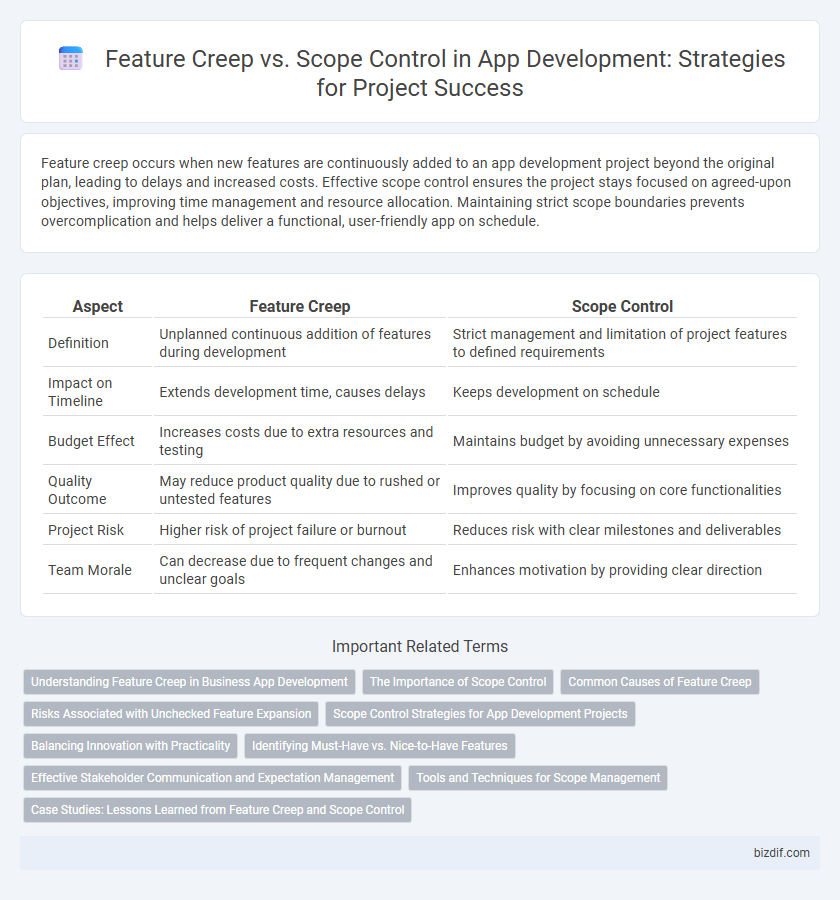Feature creep occurs when new features are continuously added to an app development project beyond the original plan, leading to delays and increased costs. Effective scope control ensures the project stays focused on agreed-upon objectives, improving time management and resource allocation. Maintaining strict scope boundaries prevents overcomplication and helps deliver a functional, user-friendly app on schedule.
Table of Comparison
| Aspect | Feature Creep | Scope Control |
|---|---|---|
| Definition | Unplanned continuous addition of features during development | Strict management and limitation of project features to defined requirements |
| Impact on Timeline | Extends development time, causes delays | Keeps development on schedule |
| Budget Effect | Increases costs due to extra resources and testing | Maintains budget by avoiding unnecessary expenses |
| Quality Outcome | May reduce product quality due to rushed or untested features | Improves quality by focusing on core functionalities |
| Project Risk | Higher risk of project failure or burnout | Reduces risk with clear milestones and deliverables |
| Team Morale | Can decrease due to frequent changes and unclear goals | Enhances motivation by providing clear direction |
Understanding Feature Creep in Business App Development
Feature creep in business app development refers to the continuous addition of new features beyond the initial project scope, often leading to increased complexity and delayed delivery. This phenomenon can dilute the app's core functionality, making it harder for users to navigate and reducing overall user satisfaction. Effective scope control involves setting clear priorities, maintaining strict requirements management, and regularly reviewing feature requests to balance innovation with usability and timely completion.
The Importance of Scope Control
Effective scope control is critical in app development to prevent feature creep, which can lead to project delays, budget overruns, and compromised user experience. Maintaining clear project goals and rigorous requirements management helps ensure that development stays aligned with the intended functionality and delivery timeline. Prioritizing core features and using agile methodologies facilitates timely iterations without diluting the app's value or overwhelming resources.
Common Causes of Feature Creep
Common causes of feature creep in app development include unclear project requirements, frequent stakeholder requests, and lack of disciplined scope management. Developers often face pressure to incorporate additional functionalities beyond the original plan, which leads to increased complexity and delayed delivery. Effective scope control involves setting clear objectives, prioritizing core features, and establishing strict change management protocols to prevent scope expansion.
Risks Associated with Unchecked Feature Expansion
Unchecked feature expansion in app development significantly increases project complexity, leading to higher risks of budget overruns and missed deadlines. Excessive additions dilute core functionalities, resulting in a confusing user experience and potential performance issues. Effective scope control minimizes these risks by maintaining clear project boundaries and prioritizing essential features for optimal app quality.
Scope Control Strategies for App Development Projects
Effective scope control strategies for app development projects include defining clear project objectives, prioritizing key features, and implementing iterative development processes such as Agile or Scrum. Utilizing requirement traceability matrices and continuous stakeholder communication helps prevent scope creep and ensures alignment with business goals. Regular scope reviews and change management protocols minimize resource overruns and maintain project timelines.
Balancing Innovation with Practicality
Feature creep often derails app development, introducing unnecessary complexity that hampers user experience and delays launches. Maintaining strict scope control ensures the project remains focused, delivering core functionalities that align with user needs and business goals. Balancing innovation with practicality involves prioritizing essential features while iteratively integrating improvements based on user feedback and market trends.
Identifying Must-Have vs. Nice-to-Have Features
Identifying must-have versus nice-to-have features is critical in app development to prevent feature creep and maintain scope control. Must-have features fulfill core user needs and ensure the app's primary functionality, while nice-to-have features enhance user experience but can be deferred to later phases. Prioritizing features based on user research and project goals helps streamline development, reduce costs, and avoid timeline overruns.
Effective Stakeholder Communication and Expectation Management
Effective stakeholder communication and expectation management are critical in balancing feature creep and scope control during app development. Clear, consistent updates and defined project goals help prevent unrealistic demands and keep the development team aligned with stakeholders' priorities. Implementing structured feedback loops ensures all parties understand trade-offs, minimizing scope expansion and enhancing timely delivery.
Tools and Techniques for Scope Management
Effective scope management in app development relies on tools like Jira and Trello to monitor project progress and prevent feature creep. Techniques such as MoSCoW prioritization and regular stakeholder reviews ensure features align with core objectives and timelines. Implementing change control processes within platforms like Azure DevOps further enforces discipline, maintaining focus on essential deliverables.
Case Studies: Lessons Learned from Feature Creep and Scope Control
Case studies in app development reveal that feature creep often leads to delayed launches and inflated budgets, undermining product quality and user experience. Successful scope control involves setting clear priorities, continuous stakeholder communication, and iterative development to maintain focus and deliver value. Lessons learned emphasize the need for disciplined project management to balance innovation with realistic goals, ensuring app success and customer satisfaction.
Feature creep vs Scope control Infographic

 bizdif.com
bizdif.com